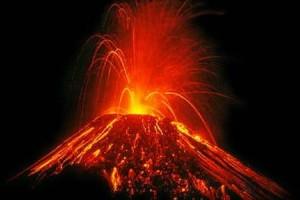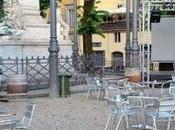

Wikipeia image courtesy Geophile71
Ambrym, a large basaltic volcano with a 12-km-wide caldera, is one of the most active volcanoes of the New Hebrides arc.
A thick, almost exclusively pyroclastic sequence, initially dacitic, then basaltic, overlies lava flows of a pre-caldera shield volcano. The caldera was formed during a major plinian eruption with dacitic pyroclastic flows about 1900 years ago. Post-caldera eruptions, primarily from Marum and Benbow cones, have partially filled the caldera floor and produced lava flows that ponded on the caldera floor or overflowed through gaps in the caldera rim. Post-caldera eruptions have also formed a series of scoria cones and maars along a fissure system oriented ENE-WSW.
Ambrym is a volcanic island in the archipelago of Vanuatu (formerly known as the New Hebrides). It is well known for its highly active volcanic activity that includes lava lake formation.
Located near the center of the long Vanuatuan archipelago, Ambryn is roughly triangular in shape, about 50 km (31 mi) wide. With 677.7 square kilometres (261.7 sq mi) of surface area, it is the fifth largest island in the country. The summit at the center of the island is dominated by a desert-like caldera, which covers an area of 100 square kilometres (39 sq mi).
With the exception of human settlements, the rest of the island is covered by thick jungle.
Historic Eruptions
The eruption history is very well documented and goes back to approx. 400 AD. A full overview can be found here.
Eruptions
Eruptions have apparently occurred almost yearly during historical time from cones within the caldera or from flank vents. However, from 1850 to 1950, reporting was mostly limited to extra-caldera eruptions that would have affected local populations.
Ambrym has recent eruptions in 1986, 1988-1991, 1994 and from 1996 until today (2012)

Wikipedia image courtesy Geophile71

Courtesy Olivier Morice – Niri Membelsu crater

Looking in the crater

1988 lava flow

3-D Google earth image of the active craters

Google satellite view of the island
Earthquakes
The list below shows the earthquake activity in a narrow radius around the volcano. Unfortunately we are only able to report the stronger earthquakes reported by the most important seismological agencies in the world. Our earthquakes database began registering early 2012.

SRC Location UTC Date/time M D INFORMATION
ER Seismicity Startup Record Jan 01 00:00 AM 0.1 0.1 MAP
Enter Email (not compulsory)
Your current location
MMI II (Very weak shaking)
?
People :
Felt by persons at rest, on upper floors or favorably placed.
MMI III (Weak shaking)
?
People :
Felt indoors; hanging objects may swing, vibration similar to passing of light trucks, duration may be estimated, may not be recognized as an earthquake.
MMI IV (Light shaking)
?
People :
Generally noticed indoors but not outside. Light sleepers may be awakened. Vibration may be likened to the passing of heavy traffic, or to the jolt of a heavy object falling or striking the building.
Fittings :
Doors and windows rattle. Glassware and crockery rattle. Liquids in open vessels may be slightly disturbed. Standing motorcars may rock.
Structures :
Walls and frames of buildings, and partitions and suspended ceilings in commercial buildings, may be heard to creak.
MMI V (Moderate shaking)
?
People :
Generally felt outside, and by almost everyone indoors. Most sleepers awakened. A few people alarmed.
Fittings :
Small unstable objects are displaced or upset. Some glassware and crockery may be broken. Hanging pictures knock against the wall. Open doors may swing. Cupboard doors secured by magnetic catches may open. Pendulum clocks stop, start, or change rate.
Structures :
Some large display windows cracked. A few earthenware toilet fixtures cracked.
MMI VI (Strong shaking)
?
People
Felt by all. People and animals alarmed. Many run outside. Difficulty experienced in walking steadily.
Fittings :
Objects fall from shelves. Pictures fall from walls. Some furniture moved on smooth floors, some unsecured free-standing fireplaces moved. Glassware and crockery broken. Very unstable furniture overturned. Small church and school bells ring. Appliances move on bench or table tops. Filing cabinets or “easy glide” drawers may open (or shut).
Structures :
Slight damage to buildings with low standard. Some stucco or cement plaster falls. Large display windows broken. Damage to a few weak domestic chimneys, some may fall.
Environment :
Trees and bushes shake, or are heard to rustle. Loose material may be dislodged from sloping ground, e.g. existing slides, talus slopes, shingle slides.
MMI VII (Very strong shaking)
?
People
General alarm. Difficulty experienced in standing. Noticed by motorcar drivers who may stop.
Fittings :
Large bells ring. Furniture moves on smooth floors, may move on carpeted floors. Substantial damage to fragile contents of buildings.
Structures :
Unreinforced stone and brick walls cracked. Low standard buildings cracked with some minor masonry falls. A few instances of damage to buildings of ordinary workmanship. Unbraced parapets, unbraced brick gables, and architectural ornaments fall. Roofing tiles, especially ridge tiles may be dislodged. Many unreinforced domestic chimneys damaged, often falling from roof-line. Water tanks Type I burst. A few instances of damage to brick veneers and plaster or cement-based linings. Unrestrained water cylinders (hot-water cylinders) may move and leak. Some common windows cracked. Suspended ceilings damaged.
Environment :
Water made turbid by stirred up mud. Small slides such as falls of sand and gravel banks, and small rock-falls from steep slopes and cuttings. Instances of settlement of unconsolidated or wet, or weak soils. Some fine cracks appear in sloping ground. A few instances of liquefaction (i.e. small water and sand ejections).
MMI VIII (Severe shaking)
?
People
Alarm may approach panic. Steering of motorcars greatly affected.
Structures :
Low standard buildings heavily damaged, some collapse. ordinary workmanship buildings damaged, some with partial collapse. Reinforced masonry or concrete buildings damaged in some cases. A few instances of damage to buildings and bridges designed and built to resist earthquakes. Monuments and pre-1976 elevated tanks and factory stacks twisted or brought down. Some pre-1965 infill masonry panels damaged. A few post-1980 brick veneers damaged. Decayed timber piles of houses damaged. Houses not secured to foundations may move. Most unreinforced domestic chimneys damaged, some below roof-line, many brought down.
Environment :
Cracks appear on steep slopes and in wet ground. Small to moderate slides in roadside cuttings and unsupported excavations. Small water and sand ejections and localized lateral spreading adjacent to streams, canals, lakes, etc.
MMI IX (Violent shaking)
?
Structures
Many low standard buildings destroyed. Ordinary workmanship buildings heavily damaged, some collapse. Reinforced masonry or concrete buildings damaged, some with partial collapse. Buildings and bridges designed and built to resist earthquakes damaged in some cases, some with flexible frames seriously damaged. Damage or permanent distortion to some buildings and bridges, designed and built to normal use standards. Houses not secured to foundations shifted off. Brick veneers fall and expose frames.
Environment :
Cracking of ground conspicuous. Landsliding general on steep slopes. Liquefaction effects intensified and more widespread, with large lateral spreading and flow sliding adjacent to streams, canals, lakes, etc.
Write your experience and/or additional text here (max. 500 characters)







